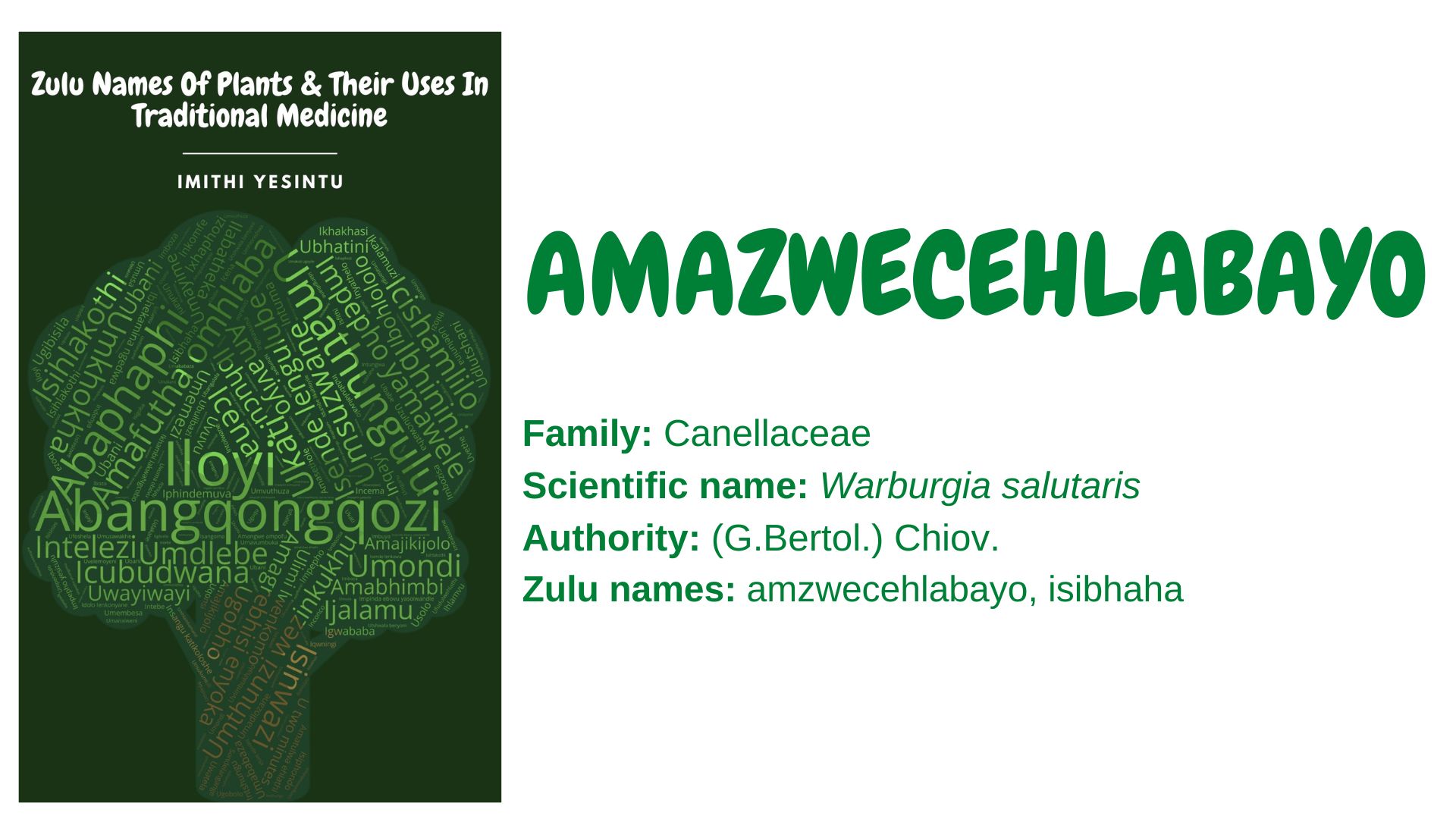Family: Canellaceae
Scientific name: Warburgia salutaris
Authority: (G.Bertol.) Chiov.
Synonyms: Chibaca salutaris Bertol.f., Warburgia breyeri Pott
Zulu names: amazwecehlabayo, isibhaha
Other names: pepper-bark tree (English) peperbasboom (Afrikaans)
Plant description: W. salutaris is an evergreen tree that can grow up to 10 m in height. It has glossy leaves with a paler underside, green flowers, fissured aromatic and pungent bark, and plum-shaped fruits containing several seeds. It is found growing in eastern and southern Africa occuring in montane forests.
Uses:
- The leaves are used as a condiment (culinary herb and spice) to give food a peppery taste.
- The leaves are used to make an ointment to treat mild skin inflammation and painless sores.
- The leaves are used to make a decoction that is taken orally to treat open wounds, bruises, sprains, and bone fractures.
- The bark can also be ground to powder and mixed with the leaves of Cannabis sativa L. (insangu), and smoked to treat a dry cough.
- The bark is used to treat a headache. The roots are ground to fine powder and mixed with Erythrophleum lasianthum (umbhemiso) and the mixture taken as snuff.
- The powdered bark is used to licked to relieve or loosen the sputum in the chest and to get rid of ulcers and internal wounds.
- The bark is used to make an emetic to treat various respiratory ailments. The bark is used to make a decoction that is taken orally to treat cough, colds, influenza, TB, bronchial infection, and sinus.
- The bark is used to treat toothache. The powdered bark is applied inside the hole of a tooth.
- The bark is used to make an ointment to treat penile irritation and chancres.
- The bark is ground to powder and mixed with various types of fat to make ointment for treating sores, open wounds, and skin irritation.
- The bark is used for steaming to treat skin problems.
- The bark is used to treat isibhobo, abdominal pain caused by stomach acidity. The bark infusion is taken orally to treat diarrhoea.
- The bark is used as a purgative for febrile complaints.
- The bark is used in douching to treat urethra inflammation. The bark is also used to treat rheumatism.
- The bark is used to make intelezi, a protective charm that may be sprinkled around the homestead to ward off witchcraft.
- The bark is used to make soap and as a bathing agent (a substance added to water when bathing) to protect the body from various forms of witchcraft.
- The bark is used as a lucky charm.
- The bark is rich in essential oils. Hence it may be used to make protection oils.
- The tree can be cultivated as a hedge, shade tree, or an ornamental.
Even though the leaves and roots are useful, the bark is the most utilized part of the tree. The bark can be chewed and swallowed, it can be made into an ointment (or a paste) that is applied topically, it can be made into a decoction or infusion that is taken orally, anally, or vaginally, it can be smoked, and used as a bathing agent.
You can buy isibhaha on the IMTHI YESINTU SHOP:
Isibhaha 100g Spice, Isibhaha 70g Spice, Isibhaha Refills, Isibhaha 50g medicine powder, Isibhaha 50g coarse fragments
Safety precaution:
The use of traditional medicine in prescribed dosages will yield good results. Misuse and abuse may lead to complications. Speak to your doctor or a herbalist for the best outcomes. You can also visit the imithiyesintu website and social media or email: info@imithiyesintu.co.za to learn more about traditional medicine.
References and further reading:
- Bryant, A.T., 1966. Zulu medicine and medicine men. C. Struik, Cape Town (originally published in 1909 in the Annals of Natal Museum).
- Coates Palgrave, K., 1977. Trees of southern Africa. Veld & Flora, 63(4), pp.8.
- Codd, L.E., 1976. Canellaceae. Flora of Southern Africa, 22, pp.39-41.
- Cunningham, A.B., 1988. An investigation of the herbal medicine trade in Natal/KwaZulu. Institute of Natural Resources Investigative Report Issue 29. Institute of Natural Resources, Pietermaritzburg.
- Gerstner, J., 1939. A preliminary checklist Zulu names of plants with short notes. Bantu Studies.
- Herman, P.P.J. and Retief, E., 1997. Plants of the northern provinces of South Africa: keys and diagnostic characters. Strelitzia, 6, pp.1-681.
- Hutchings, A., Scott, A.H., Lewis, G. and Cunningham, A.B. 1996. Zulu Medicinal Plants. An Inventory. University of Natal Press, Pietermaritzburg.
- Kokwaro, J.O., 1993. Medicinal plants of east Africa. Kenya Literature Bureau, Nairobi, 2, pp.56.
- Mhlongo, L.S. and Van Wyk, B.E., 2019. Zulu medicinal ethnobotany: New records from the Amandawe area of KwaZulu-Natal, South Africa. South African Journal of Botany, 122, pp.266-290.
- Philander, L.A., 2011. An ethnobotany of Western Cape Rasta bush medicine. Journal of ethnopharmacology, 138(2), pp.578-594.
- Pooley, E., 1993. The complete field guide to trees of Natal, Zululand and Transkei. Natal Flora Publications Trust, Natal Herbarium, Durban.
- Kotina, E.L., Van Wyk, B.E. and Tilney, P.M., 2014. Anatomy of the leaf and bark of Warburgia salutaris (Canellaceae), an important medicinal plant from South Africa. South African Journal of Botany, 94, pp.177-181.
- McGaw, L.J., Lall, N., Meyer, J.J.M., and Eloff, J.N., 2008. The potential of South African plants against Mycobacterium infections. J. Ethnopharmacol. 119, pp. 482–500.
- Neuwinger, H.D., 2000. African traditional medicine: a dictionary of plant use and applications. With supplement: search system for diseases. Medpharm.
- Van Wyk, B.E., Van Oudtshoorn, B., and Gericke, N., 2009. Medicinal plants of South Africa. Briza Publications, Pretoria. pp. 308 – 309.
- Venter, F. and Venter, J.A., 2002. Making the most of indigenous trees, Briza Publications. Pretoria, South Africa.
- Watt. J.M. and Breyer-Brandwijk. M.G. 1962. The medicinal and poisonous plants of Southern and Eastern Africa. E. & S. Living-stone Ltd., London.
You Can Order Your Copy Of The Book By Emailing: info@imithiyesintu.co.za
Feel Free To Add Other Uses Of This Plant In The Comment Section Below:

